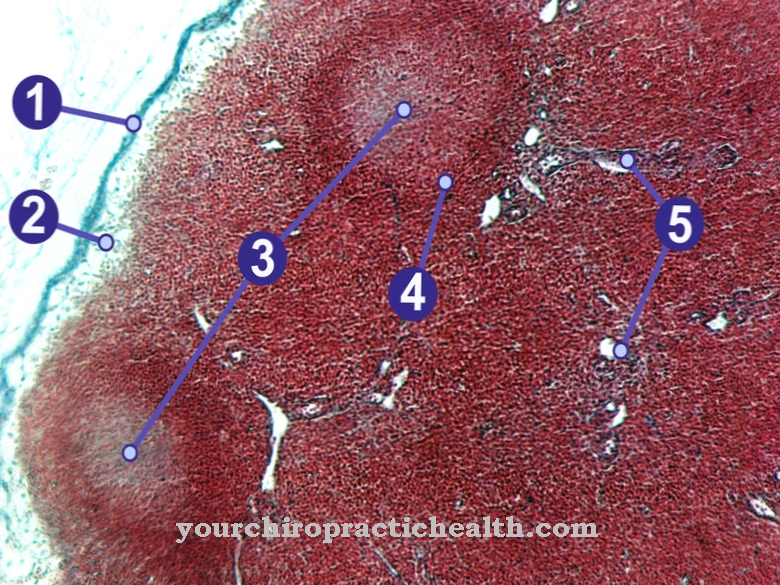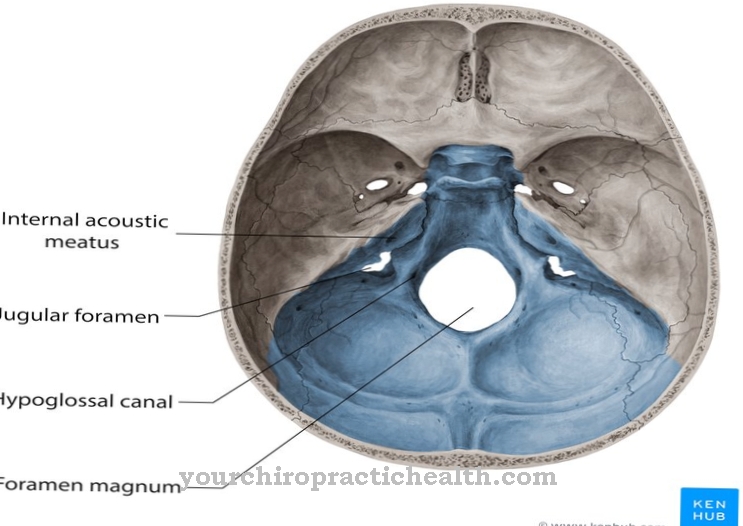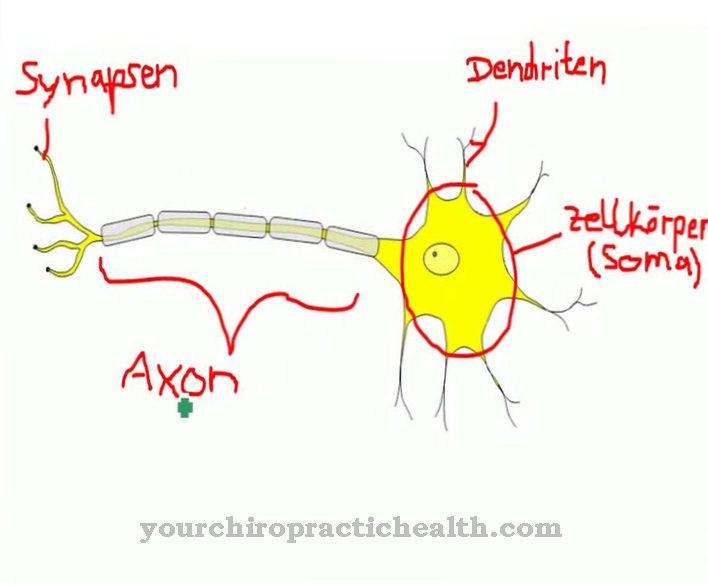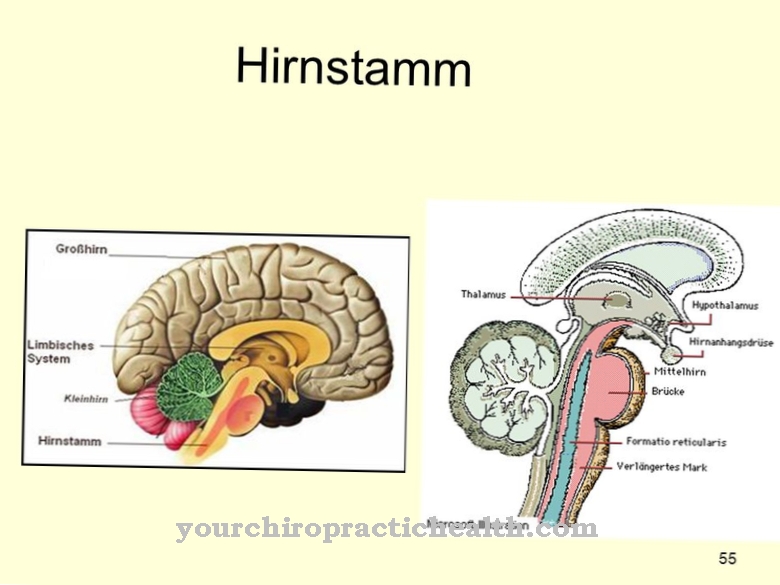Of the Trigeminal nerve owes its name to the three-part structure of the eye, upper jaw and lower jaw branches. Its main task is trigeminal perception and the transmission of neural signals from the brain to specific muscles in the three areas. Typical diseases that affect the trigeminal nerve are lesions, trigeminal neuralgia and neuroma, and meningitis, increased incranial pressure and sinusitis.
What is the trigeminal nerve?
In contrast to other cranial nerves, the trigeminal nerve does not transmit neuronal signals that originate from certain sensory cells. Instead, it plays a role in trigeminal perception, which is named after it and is based on chemical stimuli.
These stimuli can come from different areas, but they have one thing in common: they have an irritating effect and, if they are strong, they usually provoke a defense reaction. Examples are strong smells such as ammonia or irritation of the eyes with onion fumes. According to its function, the trigeminal nerve does not form a single nerve cord, but rather stretches its branches in three directions: the eye region, the upper jaw and the lower jaw. All three branches are located near other nerves that process modality-specific stimuli.
Furthermore, the trigeminal nerve represents the fifth of a total of twelve cranial nerves and is one of the branchial arch nerves. This name goes back to the location of the nerves during embryonic development: They arise from the first gill arch. Part of the trigeminal nerve, the branch of the lower jaw, essentially corresponds to the nerve of the first branchial arch in adults.
Anatomy & structure
The anatomy of the trigeminal nerve distinguishes three branches of the cranial nerve, each of which covers different areas in the head and from there both receive signals and transmit commands to muscles. The branch of the eye (ophthalmic nerve) extends right up to the visual cells, while the branch of the maxilla (maxillary nerve) creates a sensitive connection to the skull.
The third branch of the trigeminal nerve is the mandibular nerve; it forms the signal bridge to the lower jaw with the tongue, soft palate, mastication muscles and tympanic membrane tensioners. The individual branches of the trigeminal nerve are characterized by further ramifications, so that they can each cover a larger area. In addition to its three branches, the trigeminal nerve also has four cranial nerve nuclei in the brain: the nucleus motorius nervi trigemini, nucleus mesencephalicus nervi trigemini, nucleus pontinus nervi trigemini and nucleus spinalis nervi trigemini.
Function & tasks
At the functional level, the trigeminal nerve is responsible for the trigeminal perception, which is named after it. This type of perception is the processing of stimuli that do not only come from a specific modality. A trigeminal stimulus usually causes irritation in the body and initiates protective and defense mechanisms. The olfactory cells in the nose register a strong smell of ammonia, for example, which is an indicator of harmful conditions in the immediate environment or signals inedible food.
The olfactory stimulus triggers electrical potentials in the olfactory cells, which run via the olfactory nerve to the brain. Strong stimuli lead to the emergence of many action potentials one after the other, which is a strong signal. The finely branched nasal branches (rami nasales) absorb the information and pass it through other parts of the upper jaw branch to the central nervous system (CNS). In the opposite direction, the CNS can now command various muscles to contract - for example to recoil, grimace (which is intended to restrict the flow of air into the nose) or even to react with disgust and nausea.
The nucleus motorius nervi trigemini is a motor core that is responsible for controlling movement and is located in the hindbrain, while the other three nuclei are located in the brain stem and, as sensory nuclei, are responsible for receiving sensory perceptions. The task of the nucleus mesencephalicus nervi trigemini (literally "brain stem core of the nervus trigeminus") consists essentially in the unconscious depth perception, the nucleus pontinus nervi trigemini ("bridging core of the nervus trigeminus") takes over conscious depth perception, pressure, tension, position perception, etc. a. And the nucleus spinalis nervi trigemini ("spinal nucleus of the nervus trigeminus") is protopathically sensitive, i. H. it absorbs temperature, strong pressure and itching stimuli.
You can find your medication here
➔ Medicines for painDiseases
Damage to the trigeminal nerve in some cases leads to peripheral or central sensitivity disorders. The peripheral lesion usually affects only one of the three branches and leads to impaired perception or to the complete loss of trigeminal perception in this specific area. In contrast, the central lesion does not affect the branches of the trigeminal nerve, but the nuclei.
If the nucleus spinalis nervi trigemini is damaged, the affected person experiences circular failures. In contrast, trigeminal neuralgia manifests itself in severe pain, which, along with cluster headaches, is one of the most intense types of pain, occurs in the form of pain attacks and lasts for up to two minutes. Doctors use medication to treat trigeminal neuralgia, but can also perform surgery in stubborn cases. Another disease of the trigeminal nerve is trigeminal neuroma, a tumor in the nerve sheath.
Meningitis, increased incranial pressure (intracranial pressure) and sinusitis (sinusitis) can also affect the trigeminal nerve and typically trigger pressure pain through it. Doctors therefore check the trigeminal pressure points on both halves of the face if they suspect a corresponding disease in order to identify changes. The therapy in these cases depends on the cause.



























